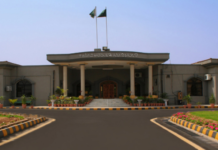ISLAMABAD: The government announced to take ‘decisive action’ on electricity tariff aimed at avoiding Rs420 billion annual subsidies but approved to supply subsidised gas to five export oriented sectors that will cost taxpayers Rs63.5 billion.
The Economic Coordination Committee (ECC) of the Cabinet allowed provision of imported Re-gasified Liquefied Natural Gas (RLNG) to five Punjab-based industries at half of the existing prices despite having no budgetary allocations. The Rs63.5 billion subsidy to textile, carpets, leather, sports and surgical goods will be given by issuing a supplementary grant, said officials of the Finance Ministry.
“We will soon take decisive steps on electricity prices increase,” said Information Minister Fawad Chaudhry while addressing media after the ECC meeting, chaired by Finance Minister Asad Umar.
“The ECC did not take a decision on power tariff increase due to absence of Power Minister Omar Ayub, who is in China,” he said. “Naya Pakistan will emerge after eight to ten months when the government would clear the mess left behind by the last Pakistan Muslim League-Nawaz (PML-N) government.”
While making a case for electricity tariff increase, the minister said the current electricity sale price of Rs11.71 per unit has shot up due to setting up of expensive power generation plants and net hydel profit payments made to provinces by the PML-N government.
 “Against the Rs11.71 end consumer price, the cost of generation was earlier Rs12.90 per unit and the government was bearing Rs1.19 per unit subsidy,” he added.
“Against the Rs11.71 end consumer price, the cost of generation was earlier Rs12.90 per unit and the government was bearing Rs1.19 per unit subsidy,” he added.
After including the annual increments being paid to power distribution companies (Discos) and addition of new power plants, the cost of electricity generation has now increased to Rs15.53 per unit. This is Rs2.63 per unit or 20.4% higher than the existing notified prices.
He said only because of expensive power generation, the cost of electricity would jump by Rs1.32 per unit. Another Rs0.86 per unit surge is on account of net hydel profit. However, compared with the current sale price of Rs11.71 per unit, the new average prices are Rs3.82 per unit or 32.6% higher.
The minister said the Qauid-e-Azam solar plant was producing electricity at a price of Rs17 per unit –claiming that it was the highest solar tariff in the world. He said the government has not yet taken a decision on how much of Rs3.82 per unit additional power generation cost will be passed on to user.
Currently, the government is bearing Rs2.63 per unit loss that translates into Rs34 billion to Rs36 billion monthly loss. This comes to on an average Rs420 billion annual subsidy.
Chaudhry reiterated the government’s policy of launching probe into these power plants. Two of them Sahiwal Power Plant and Port Qasim Power Plant are setup under China-Pakistan Economic Corridor.
Other decisions
The information minister said the ECC also decided to give subsidy on supply of the RLNG to the five export-oriented sectors to make them competitive. He did not disclose the amount of subsidy.
The Petroleum Division officials said the subsidised gas supply will cost the kitty Rs63.5 billion. But the government has not budgeted the subsidy in the revised budget and will have to give supplementary grant.
In its September 14 meeting, the ECC decided to supply gas to the textile and jute, carpets, leather, sports and surgical goods sectors in Punjab at a subsidised rate. The ECC decided that the weighted average of gas tariff of such consumers will be $6.5 per mmbtu.
The decision will not be applicable to the consumers of Sindh and Khyber Pakhtunkhwa who are already taking benefit of low-priced domestically produced gas.
The notified tariff for the RLNG for the month of October is $12.5398 per mmbtu but these five Punjab-based sectors would get imported fuel at $6.5 per mmbtu, said the officials.
The system gas being supplied to five export oriented sectors will not be available from Dec to Feb winter period due to shortfall on the Sui Northern Gas Pipeline Limited (SNGPL) system. These sectors would get 300 mmcfd RLNG s for 3 months at subsidised rates that will cost the kitty Rs21.6 billion.
Similarly, during the nine-month summer season, these sectors will be entitled to get a blend of local and imported gas that will cost the kitty another Rs41.8 billion subsidy.
The SNGPL is required to make payments to the LNG suppliers within eight days of unloading of the LNG cargo and the third day after the receipt of the invoice. The ECC approved that the SNGPL will reconcile subsidy claims on weekly basis with the Finance Ministry and Petroleum Division.
The Petroleum Division also gave a briefing on the two LNG re-gasification terminals set up during the tenure of the PML-N government. The officials said Finance Minister Asad Umar wanted to reopen these deals on doubts of wrongdoing in award of these contracts.
But majority of the ECC members including Adviser to PM Razak Dawood was against reopening of these deals. They were of the view that it was not the right time to open yet another Pandora’s Box. But Umar is said to have decided that he would present the findings before the federal cabinet for a decision.
According to the Petroleum Division’s findings, the government was paying average monthly excess charges of $3.3 million to the Pakistan Gasport Consortium Limited (PGPCL) Terminal that has a total capacity of 600 mmcfd. However, the average capacity utilisation has remained at only 54%.
The authorities also did not execute Novation Agreements, which were previously signed between the Pakistan State Oil (PSO) and Qatar Gas. There are also disputes over custom charges, the officials added.


